



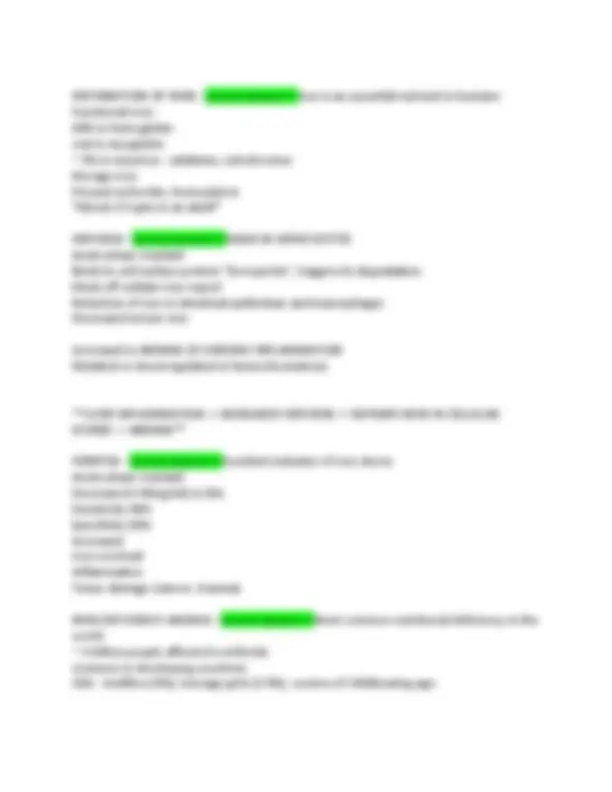
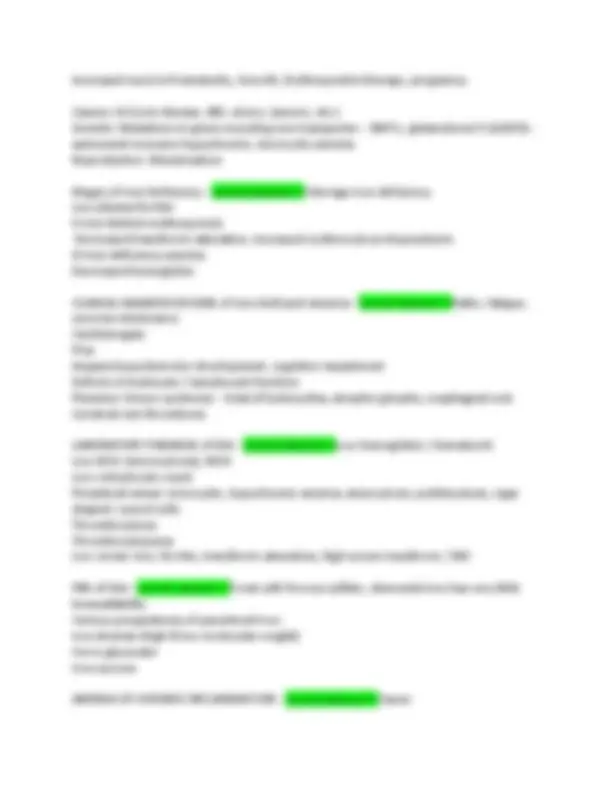





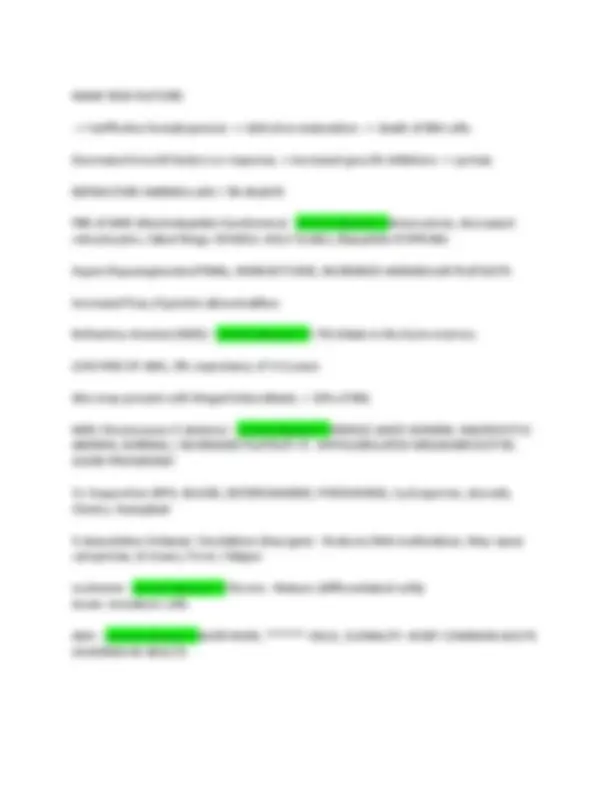





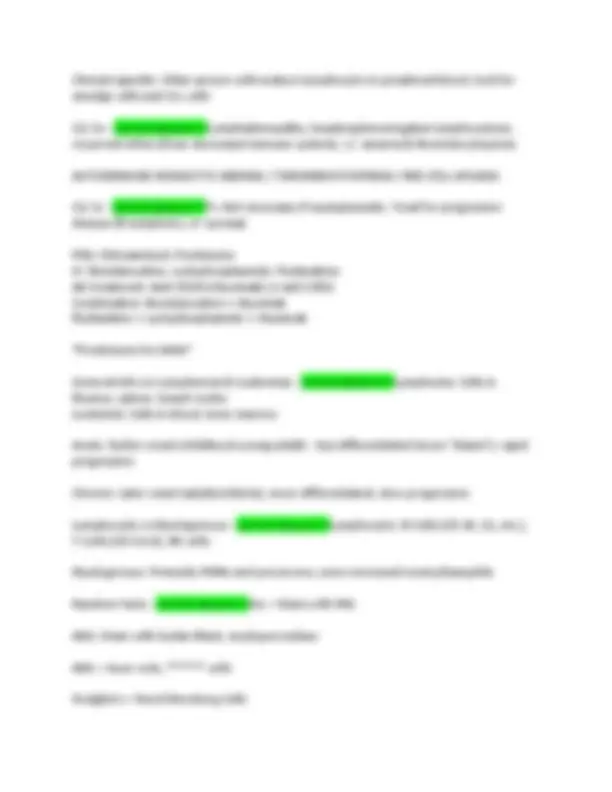


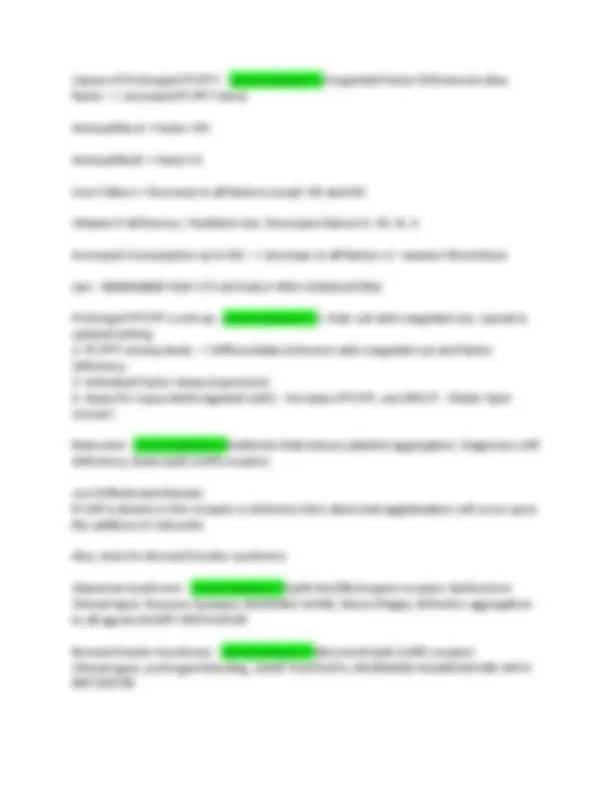
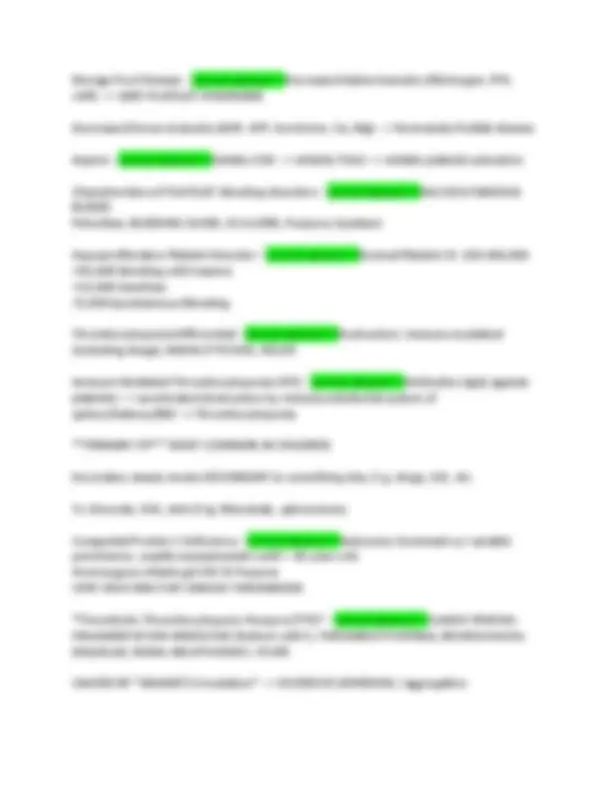
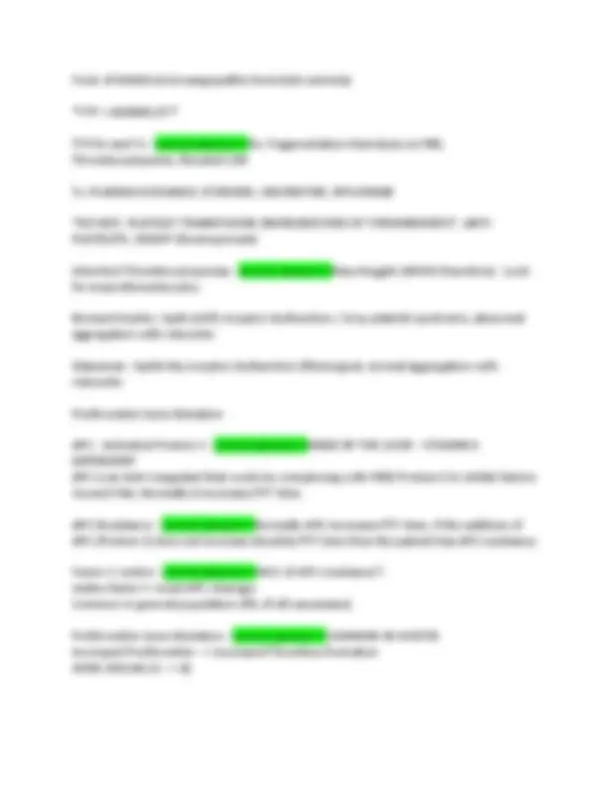



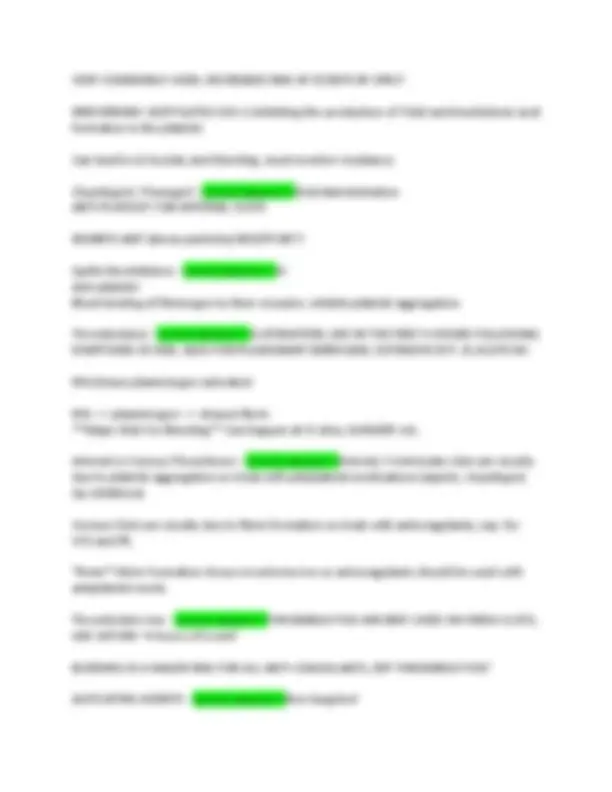
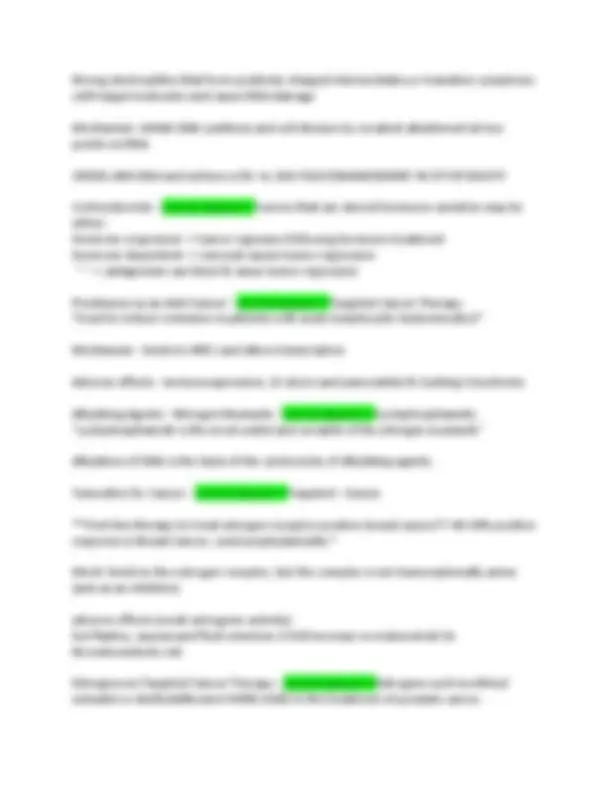
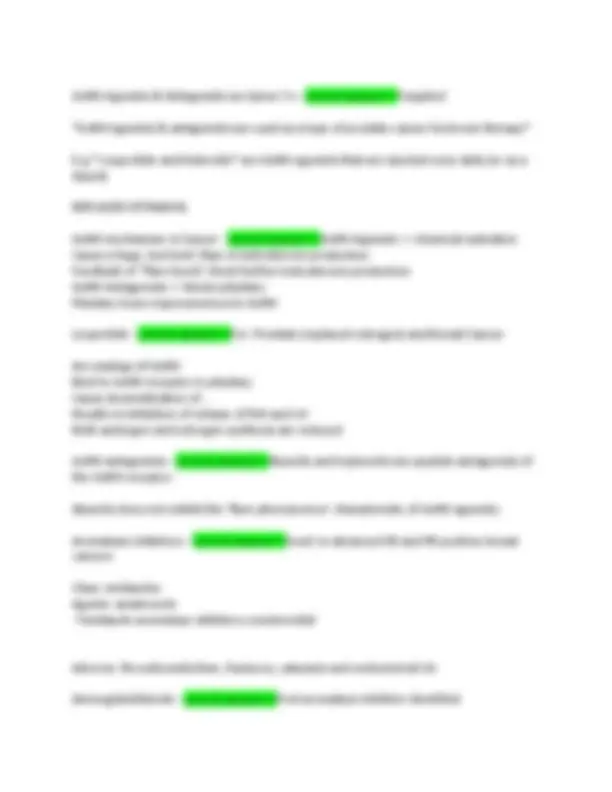
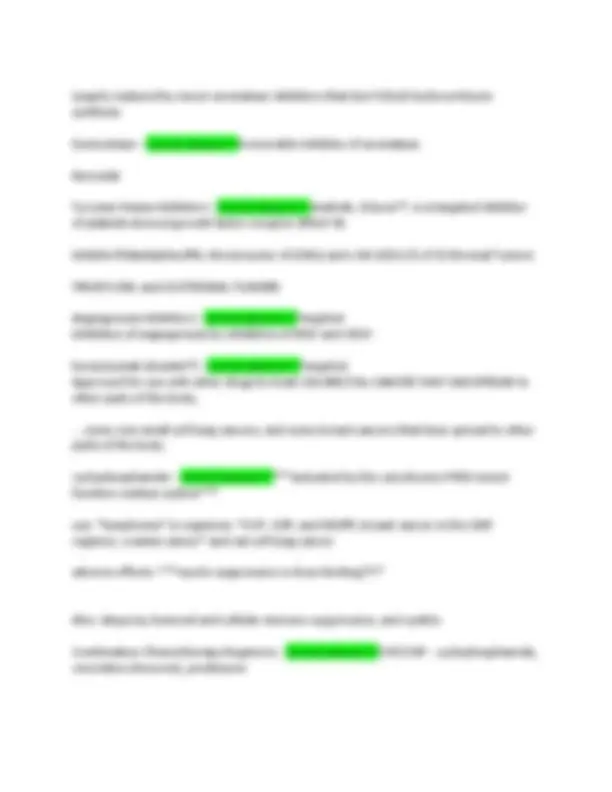




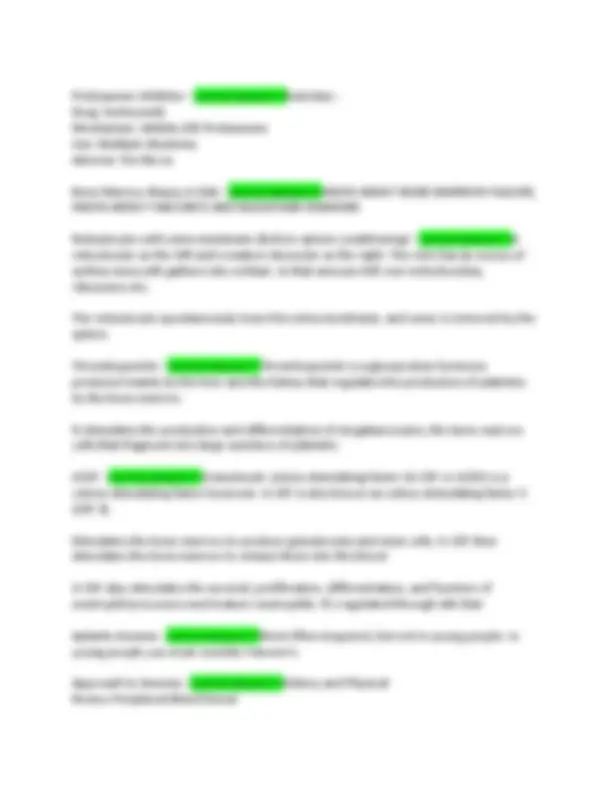





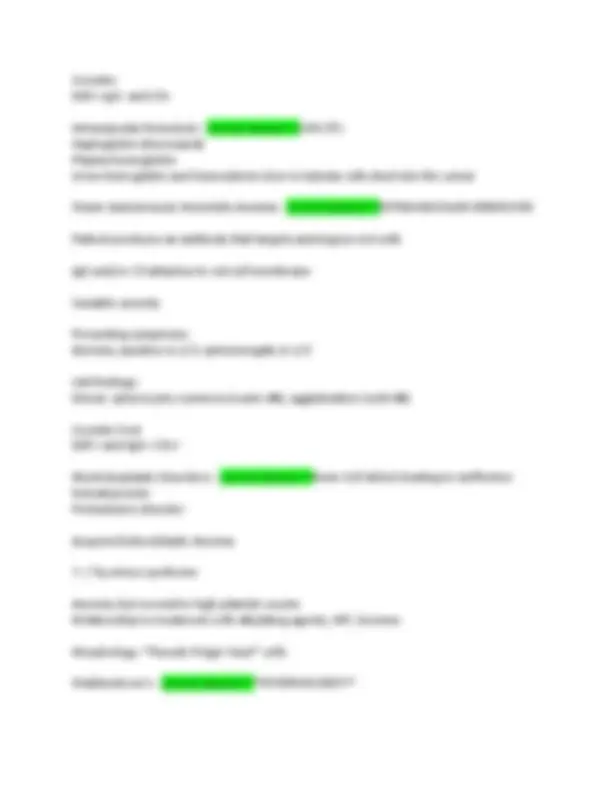
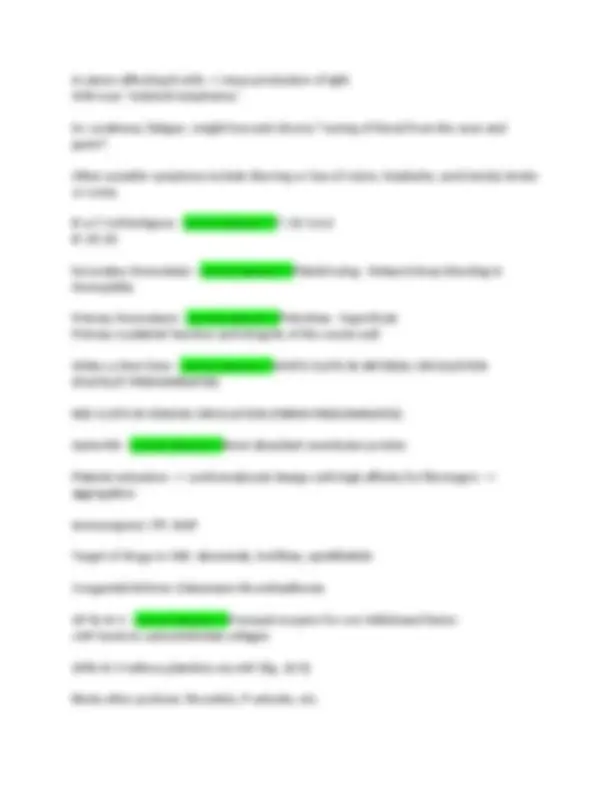

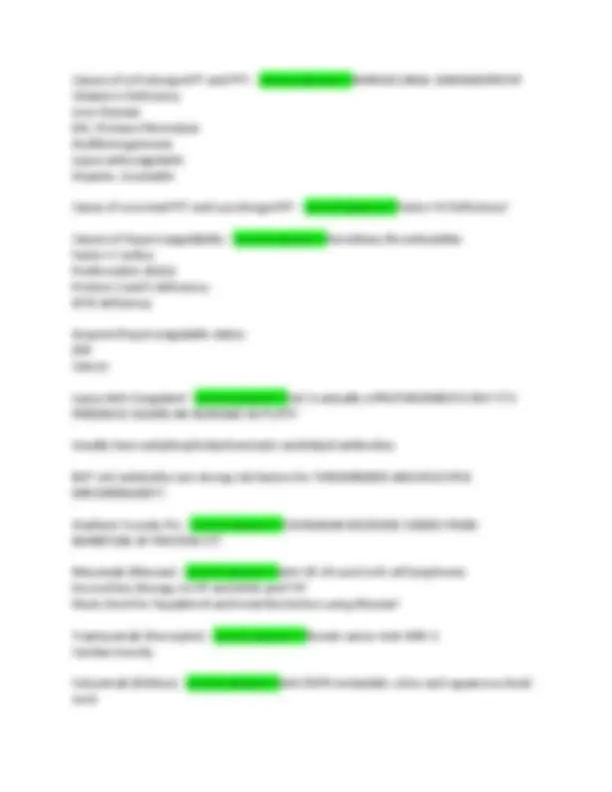



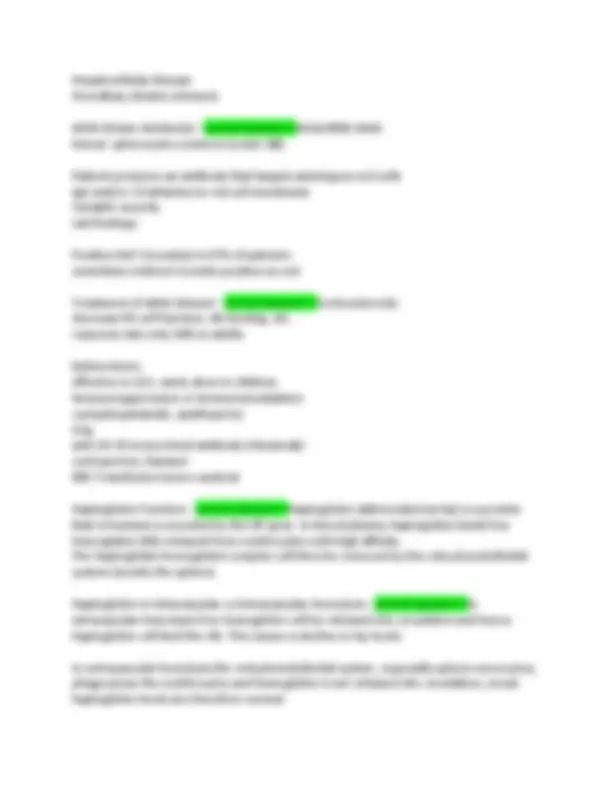
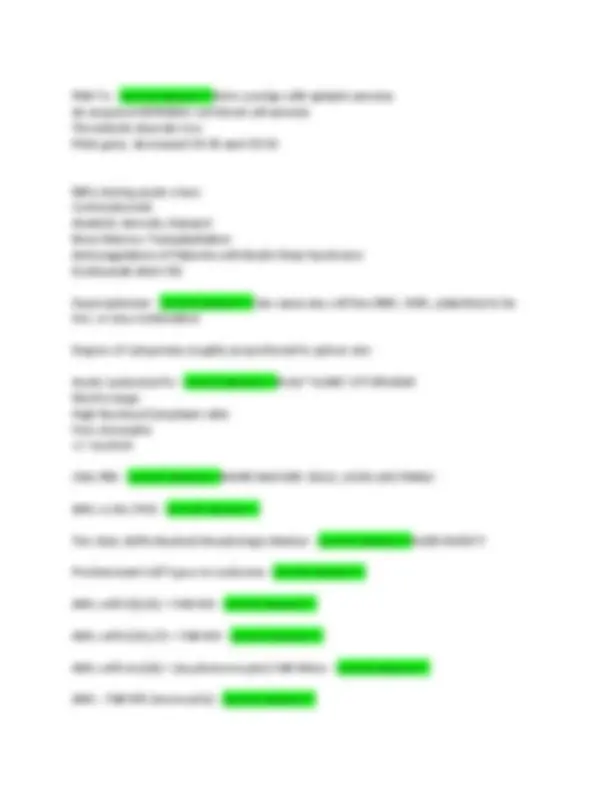




Study with the several resources on Docsity

Earn points by helping other students or get them with a premium plan


Prepare for your exams
Study with the several resources on Docsity

Earn points to download
Earn points by helping other students or get them with a premium plan
Community
Ask the community for help and clear up your study doubts
Discover the best universities in your country according to Docsity users
Free resources
Download our free guides on studying techniques, anxiety management strategies, and thesis advice from Docsity tutors
Hematopoiesis - correct answer>>the process of formation, development and differentiation of formed elements of blood A very dynamic process Highly regulated to maintain normal function Hematopoietic Stem cells - correct answer>>Rare cells that are indistinguishable morphologically from lymphocytes - Express CD34, morphologically different too Characteristics Multipotential: give rise to other hematopoietic cells Self-renewal: thereby able to maintain HSC numbers Quiescent: only dividing every few months. Thought to be promoted by niche factors within the bone marrow Protective against transformation and cancer development WBC Differential of Peripheral Blood Smear - correct answer>>Average WBC: 4,000 10,000 Neutrophils (Polys) 57-67% of WBC Lymphocytes (T, B, and NK cells); Lymphoid derived: 23-33% of WBC Monocytes (not including lymphocytes) : 3-7% Eosinophils: 1-3% Basophils: 0-1% (pretty rare)
Typology: Exams
1 / 58

This page cannot be seen from the preview
Don't miss anything!



















































Hematopoiesis - correct answer>>the process of formation, development and differentiation of formed elements of blood A very dynamic process Highly regulated to maintain normal function Hematopoietic Stem cells - correct answer>>Rare cells that are indistinguishable morphologically from lymphocytes
Pica: characterized by an appetite for substances largely non-nutritive, such as clay or chalk.[1] For these actions to be considered pica, they must persist for more than one month at an age where eating such objects is considered developmentally inappropriate. Bone Marrow Stroma - correct answer>>Hematopoiesis occurs in a special micro- environment Matrix includes: endothelial cells, adipose cells, macrophages, fibroblasts, and extracellular matrix proteins Stem cell trafficking occurs out of (mobilization) or into (homing) the matrix under influences of specific cytokines Pancytopenia and SAA (Severe Aplastic Anemia) Definitions - correct answer>>Refers to decreased blood counts in all three cell lines Severe aplastic anemia (SAA) definition COMBINES BONE MARROW HYPOCELLULARITY (<25%) & AT LEAST TWO CYTOPENIAS: Absolute neutrophil count<500/uL Anemia with low absolute retic count (<40,000/uL) Platelets <20,000/uL Fanconi Anemia - correct answer>>Congenital cause of pancytopenia, Autosomal Recessive: Notice cafe au lait, small eyes, and abnormal thumbs DNA repair disorder Diamond-Blackfan anemia - correct answer>>Congenital red cell aplasia PATIENTS PRESENT IN THE FIRST YEAR OF LIFE with macrocytic, hypoproductive anemia +/- congenital abnormalities (heart, kidney, limbs, craniofacial) Bone marrow shows PAUCITY OF ERYTHROID precursors in an OTHERWISE NORMOCELLULAR marrow Also observed is an INCREASED in number of EOSINOPHILS 85% of patients will respond to Tx with STEROIDS Unclear reason for response to steroids Acquired pure red cell aplasia - correct answer>>PARVOVIRUS B19!!! infection, especially in patients with chronic hemolytic anemia Rare disorder Can occur in the following settings: Thymoma ACQUIRED
elaborated by the kidney which favors red blood cell production and TPO stands for thrombopoietin a regulator of platelet production. Erythropoiesis Timeline - correct answer>>Note that the first RBC precursor cell, the burst-forming unit-erythroid, takes about 14 days to develop in the bone marrow. In total, the average erythrocyte takes 26 days to mature and lives about 120 days. Bone Marrow Microenvironment - correct answer>>red blood cell precursors typically head out with histiocytes which have the iron they need for hemoglobin production. To get from the sinusoid to the vein, they have to pass through small gaps in the endothelial lining of the sinusoids and sometimes they have to pass through megakakaryocytes which are also present at the membrane apertures. Regulation of Erythropoiesis - correct answer>>Intersitial renal tubular cells in the kidney posses an oxygen sensing mechanism--EPO is increased as a hypoxia inducible Factor acts on the EPO gene. Low oxygen, higher EPO from kidney, interaction of EPO with EPO receptors on erythroid progenitors. Many erythroid progenitors are going to go into apoptosis. These cells are rescued by increased EPO levels. The erythron expands and normoxia is restored to the kidney and less EPO is elaborated. Note the other adaptations to anemia shown in the diagram. Erythropoietin - correct answer>>Produced by interstitial renal tubular cells About 10 % is produced by liver Rises in response to hypoxemia or anemia Normal levels are 10-20 U/ml Renal Insufficiency causes normochromic normocytic anemia Prevents apoptosis of erythroid progenitors More About EPO - correct answer>>Gene is on chromosome 7 Native EPO has MW of 34 KD Heavily glycosylated rHEPO somewhat less glycosylated A novel rHEPO, Darbepoietin has additional glycosylation site Results in a longer half life EPO production is inversely proportional to the hematocrit level.
EPO: A Hypoxia Inducible Factor - correct answer>>EPO GENE TRANSCRIPTION NEEDS BOTH HIF1 BETA (ALWAYS ON) & ALPHA (REGULATED BY HYDROXYLATION / DEGRADATION)!!!!! HIF 1 beta is constitutively expressed, but alpha is regulated by hydroxylation, if it undergoes hydroxylation, it is then targeted by the von Hippel Lindau protein for destruction in the proteosome after ubiquitin is attached, this occurs when oxygen is ample and acts to down regulate the genes transcript. EPO RECEPTOR - correct answer>>The EPO receptor shares similarities with receptors for other growth factors such as thrombopoietin and G-CSF. Docking of EPO with its receptor allows interaction between JAK2 and EPO receptors. Phosphorylation of the JAK2 kinase initiates a signalling cascade. C. FAMILIAL ERYTHROCYTOSIS can occur in association with dominant inheritance of a TRUNCATED EPO RECEPTOR tail region which CANNONT INTERACT with phosphatase— this favors EPO independent signalling and erythrocytosis. Polycythemia Vera - correct answer>>An acquired mutation in JAK2 V617F promotes phosphorylation and activity of the signal pathway without EPO interaction— erythrocytosis occurs because it is no longer EPO dependent. Familial Erythrocytosis (involves EPOr) - correct answer>>A phosphatase can act as an inhibitor; in familial erythrocytosis there is inheritance of a truncated EPO receptor tail region which cannot interact with phosphatase—this favors EPO independent signalling and erythrocytosis Hemoglobin Curve - correct answer>> Adult Hemoglobin - correct answer>>Note that the adult hemoglobins share common alpha chain. You can predict that the A2 will go up in beta thalassemia—disorder in which beta globin is reduced or absent. Hemoglobin F is not uniformly expressed in red blood cells. Certain cells, a subpopulation, have a lot of F, so called F cells. Important Points about Fetal vs Adult Hemoglobins - correct answer>>GAMMA PREDOMINATES IN UTERO BUT THERE IS A SWITCH TO ADULT BETA IN THE THIRD TRIMESTER.
Nail beds, conjunctivae and buccal mucosa Tachycardia—severe anemia, pulse at rest is elevated Systolic flow murmur Other findings depending on the cause Reticulocyte Production Index - correct answer>>The Reticulocyte production index (RPI, also called a corrected reticulocyte count) is a calculated value used in the diagnosis of anemia. This calculation is necessary because the raw reticulocyte count is misleading in anemic patients. The problem arises because the reticulocyte count is not really a count but rather a percentage: it reports the number of reticulocytes as a percentage of the number of red blood cells. In anemia, the patient's red blood cells are depleted, creating an erroneously elevated reticulocyte count. RPI = (HCT /45) x Reticulocytes / Correction factor Hypoproliferative Anemia - correct answer>>Associated with pancytopenia Fanconi's Acquired Aplastic anemia Myelodysplastic syndrome Myelophthisis Granulomatous disease Megaloblastic anemia Anemia of Chronic Renal Failure - correct answer>>Decreased EPO production Normochromic normocytic anemia Normal iron studies LOW RETIC NORMAL MORPHOLOGY DOES NOT always correlate with BUN or creatinine Treatment of anemia with recombinant EPO PLATELET DYSFUNCTION - BLEEDING IN UREMIC PATIENTS!!! Problems with EPO - correct answer>>If hematocrit rises too quickly: thrombosis Possibly can worsen HTN Antibodies to EPO Resistance to EPO Aluminum toxicity Parathyroid hormone Increased mortality in some cancer patients Blood doping
DISTRIBUTION OF IRON - correct answer>>Iron is an essential nutrient in humans Functional iron: 80% in hemoglobin rest in myoglobin ~ 3% in enzymes - catalases, cytochromes Storage iron Present as ferritin, hemosiderin About 2-3 gms in an adult HEPCIDIN - correct answer>>MADE IN HEPATOCYTES Acute phase reactant Binds to cell-surface protein "ferroportin", triggers its degradation Shuts off cellular iron export Retention of iron in intestinal epithelium and macrophages Decreased serum iron Increased in ANEMIA OF CHRONIC INFLAMMATION Mutated or downregulated in hemochromatosis LIVER INFLAMMATION - > INCREASED HEPCIDIN - > ENTRAPS IRON IN CELLULAR STORES - > ANEMIA FERRITIN - correct answer>>Excellent indicator of iron stores Acute phase reactant Decreased (<40ng/ml) in IDA Sensitivity 98% Specificity 98% Increased Iron overload Inflammation Tissue damage (cancer, trauma) IRON DEFICIENCY ANEMIA - correct answer>>Most common nutritional deficiency in the world ~ 3 billion people affected worldwide Common in developing countries USA - toddlers (3%), teenage girls (2-5%), women of childbearing age
Decreased release of iron from macrophages to plasma Hepcidin induced by cytokines (from inflammation), released from liver, decreases release of iron from macrophages Reduced RBC life span Inadequate erythropoietin response to anemia due to the effects of IL-1, TNF, g interferon Tx: Treat the underlying disorder, EPO may help. Hereditary Hemochromatosis - correct answer>>IRON OVERLOAD Most prevalent genetic disease in whites Mutation of hepcidin gene, HFE gene Frequency of 6.4% - 9.5% Linkage disequilibrium with HLA A Low penetrance Mutation in the genes encoding TFR2, ferroportin Mutations in gene encoding hepcidin, homojuvelin - juvenile hemochromatosis Causes increased iron absorption, loss of regulation of intestinal iron absorption Problems associated with Hereditary Hemochromatosis - correct answer>>Iron is toxic to tissues: Lipid peroxidation Increased collagen formation Interaction of ROS, iron and DNA Lethal injury Predispose to HEPATOCELLULAR CARCINOMA Prussian Blue stain of liver biopsy ****Clinical Presentation of Hereditary Hemochromatosis**** - correct answer>>Males predominate: 5-7: Total body iron often exceeds 50 gm (nl 2-6 gm) Clinical manifestations seen in the 4th decade Classic triad: PIGMENT CIRRHOSIS, diabetes mellitus, SKIN PIGMENTATION Other organs: HEART (arrhythmias, cardiomyopathy), pituitary gland (HYPOGONADISM), synovium, articular cartilage (arthritis / pseudo-gout) 200 fold increased risk for HEPATOCELLULAR CARCINOMA DEATH FROM CIRRHOSIS OR CARDIAC DISEASE
Tx: Treatment: PHLEBOTOMY Dietary modification - avoid iron supplements, vitamin C, red meat Screening of family members of proband AFRICAN IRON OVERLOAD - correct answer>>Bantu siderosis Traditional beer drinkers - from non-galvanized steel drums Primarily cirrhosis, increased risk of infection - Tuberculosis Transferrin saturation not usually elevated Screening - serum ferritin Sideroblastic Anemia - correct answer>>Iron does not incorporate into protoporphyrin Builds up in Mitochondrion Detected by Perl's Prussian Blue stain Mitochondria encircle the erythroid progenitor nucleus—"ringed sideroblast" is a pathologic finding of large blocks of staining material Iron staining in normal erythroid progenitors shows up as blue dots "sideroblasts"—a normal finding Acquired Sideroblastic Anemias - correct answer>>Pseudo Pelger Huet WBC in Myelodysplastic syndromes (more later) Increased serum iron, and increased % Sat High Ferritin Presence of RINGED SIDEROBLASTS in bone marrow TX: Pyridoxine, Transfusions Can be caused by: Etoh poisoning, copper deficiency (as in gastric bypass pts), lead poisoning, pts being treated with INH (TB pts). SLIDE WILL HAVE A DIMORPHIC POPULATION OF MICROCYTIC HYPOCHROMATIC + MACROCYTIC RBCs Congenital Sideroblastic Anemia - correct answer>>Most often X-linked Deficiency of delta aminolevulinic acid synthase—the first enzymatic step in heme porphyrin production No Heme, no incorporation of iron into hemoglobin, iron builds up in the mitochondria Pyridoxine is a cofactor of the enzyme and in some patients replacement improves the anemia.
Oral Contraceptives Inborn errors of metabolism Myelodysplastic syndrome Richter Transformation - correct answer>>Transition from an indolent leukemia to an aggressive, high-grade large B-cell lymphoma Occurs in approximately 1-10% percent of all CLL patients Can occur at any time during the course of CLL. High LDH Rapid lymph node enlargement Systemic B symptoms Requires repeat lymph node biopsy to confirm the diagnosis MDS Chromosomal Deletion - correct answer>>Deletion of long arm of chromosomes 7 or 5 (5q) --> Leads to clonal expansion in 5q-: Occurs primarily in middle-aged women Characterized by macrocytic anemia and normal or increased platelet count Megakaryocytes with hypolobulated nuclei Favorable clinical course with absence of leukemic transformation M2 Chromosomal Abnormality - correct answer>>8:21 Translocation --> AML with Maturation M3 Chromosomal Translocation - correct answer>>15: Acute Promyelocytic Leukemia LOOK FOR DIC and CNS HEMORRHAGE IN HISPANIC MALES M4 Chromosomal Abnormality - correct answer>>Inversion of 16 Acute Monomyelocytic Leukemia MAY HAVE ABNORMAL EOSINOPHILS Important Translocation in CML - correct answer>>Philadelphia Chromosome 9: translocation Myeloid CD markers - correct answer>>Think Three's 13 & 33 Immature Markers (blasts) - correct answer>>CD 34 & TdT
Non-Hodgkin's Lymphoma B vs T - correct answer>>T: Thymus is the major site B: 85% of all lymphomas! Risk factors for NHL (Non-Hodgkin's Lymphoma) - correct answer>>Congenital (Wiskott- Aldrich) Organ Transplant (use of CYCLOSPORINE) Increased age Chronic Inflammation (H. pylori, Chlamidia psittaci) Autoimmune: sjorgen's, hashimoto's thyroiditis Viral: AIDS, HTLV (Japan / Caribbean), Hep. C, Herpes, EBV NHL Incidence - correct answer>>Burkitt's Lymphoma: Africa + EBV + Jaw Neoplasm Adult T-Cell Lymphoma associated with HTLV (Japan & Caribbean) IPSID (immunoproliferative small intestine disease) in M.E. HIV - NHL general characteristics - correct answer>>Very common, very treatable, possibly curable! Staged Using the Ann Arbor Scale (like Hodgkin's) Indolent form more common in adults, less differentiated more aggressive form more common in children. Indolent: Good prognosis, not curable but long life expectancy (years). Aggressive: Worse prognosis, potentially curable, short life expectancy if untreated (weeks). MORE BLASTIC AND HIGHER GRADE NHL Life expectancies - correct answer>>Longest (8-12 years) : Diffuse Well- differentiated Lymphocytic Lymphoma (DWDL) Long (5-8 years) : nodular poorly differentiated lymphocytic (NPDL) Short .5-1.5 years: Diffuse Histiolytic Lymphoma, DHL Shortest .6-.7 years: Diffuse Undifferentiated (DU)
Treat only stage I/II. Tx with local radiation followed by rituximab FLIPI risk assessment for Follicular (NHL) Lymphomas - correct answer>>One point is assigned for each of the following adverse prognostic factors: Age greater than 60 years Stage III or IV disease Greater than 4 lymph node groups involved Serum hemoglobin less than 12 g/dL Elevated serum LDH USE FLIPI RISK ASSESSMENT: Low Risk = 0-1 risk factors, intermediate r= 2 risk factors, high risk = 3+ risk factors. Treatments for Indolent Lymphomas - correct answer>>Chlorambucil + prednisone (oral) IV: CHOP, COP, Bendamustine, Rituximab, Bexxar, Zevalin, HSC transplant R-CHOP TREATMENT - correct answer>>USED FOR AGGRESSIVE LYMPHOMAS (Stage I/II) ESP DLBCL R-CHOP! Rituximab Cyclophosphamide Hydroxydaunorubicin Oncovin Prednisone Aggressive NHL - correct answer>>Diffuse Histiolytic Lymhoma (DHL) - Avg L.E. .5-1.5 y Diffuse Undifferentiated (DU) - Avg L.E. .6-.7 y DLBCL - TREAT WITH RCHOP! Burkitt's Lymphoma - correct answer>>Starry Sky, Africa, EBV, FAST GROWING JAW TUMOR C-myc ONCOGENE TRANSLOCATION! Tx: MTX or RCHOP
Hodgkin's Disease - correct answer>>NOT VERY COMMON, BUT IT IS ONE OF THE MOST TREATABLE / CURABLE! STAGING IS THE MOST IMPORTANT THING IN TREATMENT (NOT SUB-TYPE) Key Words: REED STERNBERG Cell, POPCORN Cell, Associated with SHINGLES RS Cells are THE MALIGNANT CELLS, of B cell origin CD 45-, CD 30+, CD 15+ Hodgkin's Clinical Signs / Symptoms and Dx - correct answer>>Sx: RELAPSING FEVER (Pel Ebstein), B-Symptoms, Lymphadenopathy, PRURITIS (itching esp when taking a bath), PAIN ON DRINKING ETOH!! T-cell deficiency, spreads from cervical nodes --> mediastinum / axilla --> spleen / aorta Dx: EXCISIONAL BIOPSY NOT FNA H+P, Labs, CT scan, BM biopsy Staging by Ann Arbor: I-IV, A,B,E,S (I is single node, II is multiple nodes but one side of diaphragm... etc) Hodgkin's Lymphoma Tx - correct answer>>X-ray therapy only in very localized / good cases. All other cases do CHEMO + X-RAY THERAPY! Standard Treatment ABVD - Adriamycin, Bleomycin, Vinblastine, Dacarbazine Advanced / complicated cases: BEACOPP: Bleomycin, Etoposide, Adriamyacin, Cyclophosphamide, Oncovin, Procarbizine, Prednisone For refractory disease: Brentuximab Vedotin VERY GOOD PROGNOSIS (95% Cured in Stage I, >50% in STAGE IV) Complications of Cancer Treatment - correct answer>>Alkylating Agents / Chemo / XRT : Leukemia, Infertility X-Ray Therapy (XRT) : Lung / Breast Cancer, Constrictive pericarditis, hypothyroidism
--> Ineffective hematopoiesis --> defective maturation --> death of BM cells. Decreased Growth factors or response, + increased growth inhibitors --> penias REFRACTORY ANEMIA with < 5% BLASTS PBS of MDS (Myelodysplatic Syndromes) - correct answer>>Anisocytosis, decreased reticulocytes, Cabot Rings, HOWELL-JOLLY bodies, Basophilic STIPPLING Hyper/Hyposegmented PMNs, MONOCYTOSIS, INCREASED AGRANULAR PLATELETS Increased freq of genetic abnormalities Refractory Anemia (MDS) - correct answer>>< 5% blasts in the bone marrow. LOW RISK OF AML, life expectancy of 3-6 years. Also may present with Ringed Sideroblasts. > 15% of BM. MDS Chromosome 5 deletion - correct answer>>MIDDLE AGED WOMEN, MACROCYTIC ANEMIA, NORMAL / INCREASED PLATELET CT. HYPOLOBULATED MEGAKARYOCYTES. GOOD PROGNOSIS! Tx: Supportive (EPO, BLOOD, DEFEROXAMINE, PYRIDOXINE), Cyclosporine, steroids, Chemo, transplant 5 - Azacytidine (Vidaza) / Decitabine (Dacogen) - Reduces DNA methylation, May cause cytopenias, GI issues, Fever, Fatigue. Leukemia - correct answer>>Chronic : Mature (differentiated cells) Acute: Immature cells AML - correct answer>>AUER RODS, ****** CELLS, CLONALITY. MOST COMMON ACUTE LEUKEMIA IN ADULTS.
Risks: Down syndrome, Kline-felter's, Fanconi's anemia (remember problem with HSC in BM), Etoposide, Topoisomerase II inhibitors (11q23), RADIATION, BENZENE, translocation 8;12 or 15; FAB Classification of AML - correct answer>>Rated from M0-M M0: Least differentiated (NO Differentiation) - M7: More Differentiated. AML Presentation - correct answer>>Cytopenias (Fatigue, Fever, Bleeding), Petechiae, INCREASED LEUKOCYTOSIS WITH CNS INVOLVEMENT, LUNGS OFTEN INVOLVED TOO, LOOK FOR BLASTS! M4/M5 Clinical symptoms - correct answer>>GUMS NOTE M4 associated with CHROMOSOME 16 INVERSION AML M2 Clinical Symptoms - correct answer>>GOOD PROGNOSIS: Associated with translocation of chromosomes 8; CHLOROMA (a malignant, green-colored tumor arising from myeloid tissue) CNS INVOLVEMENT. Clinical symptoms in M3 (also some in M4, M5) - correct answer>>DIC Coagulopathies. Look for a big buffy coat when blood is centrifuged. M2 Buzzwords - correct answer>>8;21 TRANSLOCATION MOST COMMON SUBTYPE OF AML GOOD PROGNOSIS M3 Buzzwords - correct answer>>YOUNG HISPANIC MALES with DIC or HEMORRHAGE 15;17 TRANSLOCATION DIC LOW PLATELETS AND LOW FIBRINOGEN TX: ALL-TRANS RETINOIC ACID Tx of AML - correct answer>>Induction Chemo --> Anthracycline + Cytarabine, BM transplant, no maintenance except M3. MANY HAVE COMPLETE REMISSION, but LONG TERM CURE RATE is 30-40% Multiple Myeloma (MM) - correct answer>>Increased monoclonal gammaglobulinopathy Increase in monoclonal IgG (usually)